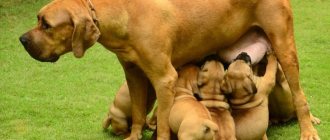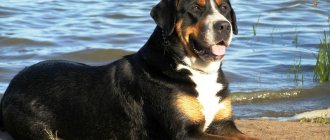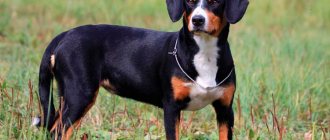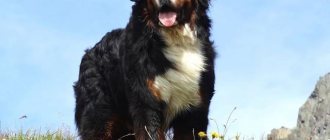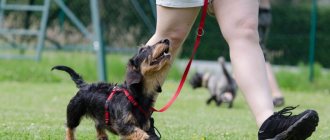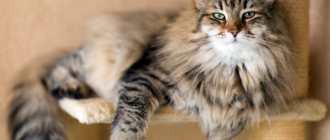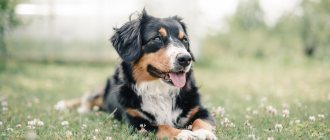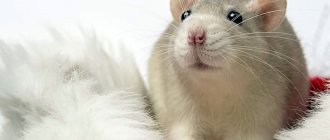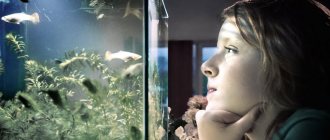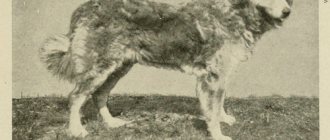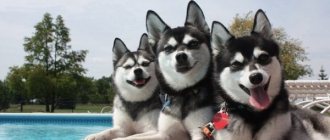| Origin: | Switzerland, Alps |
| Usage: | Companion dog (formerly a herding dog, guard dog) |
| Color: | tricolor (black with white and red) |
| Dimensions: | weight 22-27 kg, height males 54-58 cm, females 45-56 cm |
| Lifespan: | 10-14 years |
The Swiss Alps have given the world several unique dog breeds, including the Bernese, Greater Swiss, Entlebucher and Appenzeller Mountain Dog. The last of them, the Appenzeller Mountain Dog, stands out among related breeds for its harmonious physique, elegance and developed intelligence.
Story
The Appenzeller Mountain Dog owes its appearance not to systematic breeding work, but rather to natural selection. It is assumed that his ancestors were ancient Roman war dogs who came to the Alps with Caesar's army. And, indeed, the first Sennenhunds that descended from them were distinguished by quite strong aggressiveness and fighting qualities.
However, the shepherds who inhabited the Swiss Alps from ancient times had no need for warrior dogs. They needed dogs to herd and protect herds, to help with the farm, well, in extreme cases, to protect livestock, the house and the owner, but not four-legged warriors.
During the assimilation of Roman Molossians with local dog breeds, Sennenhunds appeared. But for a long time they were a single breed, or, rather, a breed group, where animals of different weight, height and build were found.
Later, Mountain Dogs began to be bred according to their variety, thus giving rise to the four breeds of modern Swiss Cattle Dogs.
As for the Swiss Appenzeller Mountain Dog itself, it was bred in Appenzell, a historical region located in the northeast of Switzerland. Medium-sized, short-haired dogs with an elegant tricolor black-white-red or brown-white-red color were used there as assistants to local shepherds and guards. But until the beginning of the 20th century, no one viewed them as anything other than working dogs, not suitable for exhibitions and breeding. And they weren’t considered a breed then.
Recognition for the Appenzellers came later, when professional dog handlers became interested in them. In 1906, the first breed club of Appenzeller Mountain Dogs was created and a stud book was established. And in 1916, the first standard of this breed appeared.
THIS IS INTERESTING! Despite the fact that breeding work had already been carried out ten years before the development of the first standard, until 1913 Appenzeller and Entlebucher Mountain Dogs were considered one breed.
International recognition for the Appenzellers came late. Until 1989, the FCI did not recognize them as a breed. But after that, Appenzellers surprisingly quickly became one of the most popular dog breeds in the world. Nowadays, of course, they are used less and less in accordance with their original purpose and have become simply companion dogs with whom it is easy and friendly to communicate, and also favorites of numerous exhibitions and sporting competitions.
Health
In general, Appenzellers have good immunity and good health. If you maintain the correct regime of walking, feeding, vaccinations, then there will be no health problems for a long time. But they appear closer to the end of life, after 7-10 years, and pets live up to 14-15 years.
Diseases
Despite their generally good health, Appenzellers have their weaknesses. So, the most common diseases are the following:
- hip dysplasia;
- osteoarthritis and other diseases of the musculoskeletal system;
- cardiomyopathy and heart failure;
- problems with the bladder and kidneys.
Vaccinations
Vaccinations on schedule are mandatory. From the nurseries, puppies go to their new owners with a veterinary passport, which contains marks on their first vaccinations. The owner’s task is to regularly visit the veterinarian with his pet and follow the vaccination schedule. Vaccination not only helps to maintain the health of an animal, it often saves its life. So, the first vaccinations are given at the age of 2-3 months - against plague, enteritis (with a second injection after 3-4 weeks), rabies (one-time, effective for 1 year). An annual revaccination is required, with marks noted in the veterinary passport. Before vaccinations, the dog is dewormed.
Description of the breed
Description of the breed with explanatory photos:
Color
Like all other Sennenhunds, the Appenzeller is distinguished by a bright, elegant tricolor color, in which on the main background, or, as dog breeders say, the “shirt,” there are spots of other, contrasting colors: reddish-red and white. Moreover, these spots are not scattered in disarray, but are located in strict accordance with the requirements prescribed in the standard.
- Red-red: above the eyebrows, muzzle, on the inside of the ears. On the chest, on the paws (reaching approximately to the hocks), on the back of the tail.
- White: Forms a "T" shaped marking on the dog's forehead and muzzle. On the chin and on the neck, on the chest it forms a mark in the form of a cross and seems to be bordered along the edges with red spots. Also, the Appenzeller must have white paws and (preferably) the tip of the tail.
THIS IS INTERESTING! The Appenzeller is the only Mountain Dog whose standard allows not only a black base color, but also a brown color. In this case, the color of the undercoat can be black, gray or fawn (in dogs with a brown “shirt”).
This color is called “Havana”
Appearance
- The head is wedge-shaped, proportional to the body, of sufficient width, but not heavy and, moreover, not coarse.
- The wide, flat forehead is divided by a clearly visible groove. The transition to the muzzle is not abrupt, but rather smooth.
- The back of the head is not convex, but rather rounded. In this case, the skull and muzzle should be in a ratio of approximately 10:9 in length.
- The bridge of the nose is flat, the lobe protrudes slightly beyond the jaw. Cheekbones and cheeks are well developed, lips are tight-fitting and not drooping.
- The teeth are strong and straight. A scissor bite is desirable, although a pincer bite is acceptable. The absence of 1-2 permolars or molars that complete the dentition is also acceptable.
- The pigmentation of the nose, edging of the lips and eyelids is black or brown depending on the color.
- The eyes are round in shape, the inner corner of the eyelid is lowered towards the nose.
- The ears are triangular with rounded tips, relatively large in size. Their stance is wide and quite high. At rest they lie close to the sides of the head, and when excited they turn forward.
- The body is rectangular in format, but not stretched, but compact.
- The neck is quite powerful and strong, medium in length. The transition from it to the withers is not abrupt. The back is of moderate length, wide, with well-developed muscles.
- The chest is oval in shape, quite deep and moderately convex. The abdomen is moderately tucked.
- The limbs are strong, strong and muscular, their set is relatively wide. The hind legs in the stance are pulled back slightly, the elbow and hock joints are parallel to the body.
- The paws are round in shape, strong, with tightly clenched, curved toes. The pads are covered with rough and thick skin.
- The tail is quite thick and medium in length. If the dog is calm, the tail is directed downwards, but in a state of excitement it is thrown over the back, so that its tip either lies on the dog’s back, or extends over it and hangs to the side.
- The Appenzeller's coat is of medium length, very thick and even, with a well-developed undercoat of the same or lighter shade than the main color.
IMPORTANT! The Appenzeller Mountain Dog should look strong and muscular, but not rough and certainly not raw. However, excessive dryness of build is also a serious drawback.
Dimensions
- Male height: 50-58 cm.
- Bitch height: 48-56 cm.
- The weight of dogs of this breed ranges from 22 to 32 kg.
The standard does not regulate the body length of dogs of this breed, but in any case it should be proportional to height.
Puppy weight and height by month:
- 1 month : 3 – 4 kg.
- 2 months : 7 - 8 kg.
- 3 months : 9.5 - 11 kg.
- 4 months: 12.5 - 14.5 kg.
- 5 months: 16-19 kg.
- 6 months 21-23 kg.
- 7 months 22-24 kg.
- 8 months 22 - 25 kg.
- 9 months 22 - 27 kg.
- 10 months 22 - 29 kg.
IMPORTANT! After a puppy reaches the age of six months, its weight increases slightly, so the weight gain per month for an individual dog can be less than half a kilogram. Most Appenzellers, who will weigh 22-26 kilograms as adults, stop gaining weight altogether at 6 months or gain very little.
Howl and bark
Bred for herding livestock and for driving herds with a voice, the Appenzeller is not averse to barking and howling. But it depends only on the owner and how much time and effort he devotes to training his pet whether the dog will bark solely on business, say, to drive away a thief, or whether he will bark endlessly for the most insignificant reason, reacting to the slightest noise.
It is very important from an early age to teach the puppy to stay at home alone and at the same time behave silently, only in this case, after the Appenzeller grows up, he will begin to bark only when it is required of him.
Nutrition
Proper nutrition also plays an important role for a normal and healthy lifestyle. The best thing to do at the first stage is to create a menu together with your veterinarian. It will help you balance your diet, taking into account your conditions. There are two possible feeding options: natural food and commercial feed.
Ready-made options are undoubtedly easier to use, especially since the necessary balance has already been maintained and the necessary additives are present. But many people prefer to cook for their pet themselves. It is important to follow some rules here:
- Do not overfeed from an early age, the volume of food for a puppy should be 7% of body weight, after 6 months it is halved.
- All food should be divided into 2-3 meals.
- The menu should include lean meat, offal, and low-fat dairy products. It is necessary to add vegetables and fruits according to the season and where you live.
- Keep track of how much your dog eats. If there is food left in the bowl, reduce the amount next time. Ideally, your pet should always be a little hungry.
- Vitamins are an essential component of a dog’s diet. If ready-made food contains them, with natural food you will need to choose it yourself.
Where is the best place to buy a puppy: nurseries
If you decide to take an Appenzeller, then it is better to buy a puppy either in a nursery or from professional breeders. This breed is still new for Russia, and therefore the list of well-known domestic nurseries dealing with this breed for 2022 is very small:
- From "Noble House"
- FIDELITY HEARD
- EBERRON
- SHEKSBURG
- Vingenium
Contacts where you can contact the breeders can be found on the websites of any of the above listed nurseries.
Price: how much does it cost
Due to the fact that there are still few dogs of this breed in Russia, and most of the producers are brought from foreign nurseries, the cost of an Appenzeller puppy cannot be small. So, a pet-class baby can be purchased for twenty thousand rubles and more, but for a promising show-class puppy you will have to pay sixty thousand and more.
Price
The price of an Appenzeller without defects, strictly corresponding to the breed standard, with a pedigree and all the necessary documents usually varies in the range of 60-70 thousand rubles in the nursery.
Purchasing an animal with such characteristics makes sense if the owner is determined to contribute to the development and preservation of the natural characteristics of the breed and has every opportunity to properly care for the dog (experience working with dogs is desirable).
Otherwise, it is better to take a puppy with different levels of culling, the cost of which starts from 5 thousand rubles. When buying a puppy of this category, you need to pay special attention to the condition of the hind legs (the breed is characterized by dysplasia), general compliance with the standard, the presence of character manifestations characteristic of the breed (general friendliness, but wary attitude towards strangers, intelligence, quick wit, etc.)
Owner reviews
Believe me, you won’t find negative reviews from the owners of these wonderful dogs all over the Internet:
Alexei:
“Two years ago we became the happy owners of a miracle named Ralph of the Appenzeller Mountain Dog breed, and during all this time we have never regretted that we bought him, and not a Bernese, as we first wanted. Our dog is incredibly smart: he seems to know commands from birth and happily carries them out. He especially loves the “Voice” team, however, this is how they are supposed to be by their breed - shepherd dogs, bark when corralling cows and sheep. And we have an excellent security guard, I must say. And it's a pleasure to walk with him. We also took him on bicycle trips with us, the dog can handle all road difficulties very well. Although no, transfers is not the right word. He just enjoys it all...”
Catherine:
“Several years ago we didn’t even know these dogs existed. And then suddenly they saw him in a book on dog breeding, and that’s it - it was love at first sight. But we learned about how wonderful animals they are, these Appenzellers, only when we got our Bertha. She's just crazy smart. From a half-glance she understands what we want from her, I never remember a case where Bertha refused to carry out some command. You can safely leave her with the children: she will look after them and watch over them, so that no stranger will offend...”
Julia:
“I always dreamed of a dog, but when my husband gave me something strange, black, white and red for my birthday, and even said that it was some kind of Appenzeller that I had never heard of in my life, I was shocked. But Sam, as we named the puppy, literally charmed us not only with his unusual appearance, but also with his intelligence. It’s a pleasure to train him; he remembers all the commands right away. You wouldn't say that Sam is malicious towards strangers, but he is an excellent guard. True, sometimes a mischievous person will steal a slipper or a glove and run with it throughout the apartment, as if teasingly: “Come on, take it away!”...
Standard
The Greater Mountain Dog is similar to other brothers in the breed, especially the Bernese, but differs in its larger size:
- height at the withers for males - from 65 to 72 cm, for females - from 60 to 68 cm;
- the weight of males is from 54 to 70 kg, and that of females is from 45 to 52 kg.
The Greater Mountain Dog is similar to other brothers in the breed
The dog's body is large, but not as massive as, for example, that of mastiffs. As for some other characteristics established by the 2003 breed standard, they look like this:
- The dog's head is strong, the skull is wide and flattened.
- The ears are medium size, triangular in shape, set high. When the dog is calm, they hang along the cheeks, and in moments of excitement they rise.
- The eyes are deep set. They are medium in size, beautiful almond-shaped. The color is brown. Blue irises (of one or both eyes) are considered a disqualifying feature. The skin around the organs of vision has dark pigmentation.
- The nose and bridge of the nose are straight, the earlobe is large and black.
- The chest is wide, the back is moderately long, straight and strong.
- The front and hind legs are straight.
- The length of the tail reaches the knee tendon. In moments of anxiety, it is slightly curved upward; when at rest, it hangs, but never wraps itself in a “ring” on its back.
- The coat is dense and short. The undercoat is dark, full and dense. The color includes several colors. The main one is black. White, red and brown spots are present on the cheekbones and throat, in the eye area, on all paws and ears, on the right and left of the chest, on the surface of the tail below. The standard also allows white spots on the withers and a “collar” of the same color.
Characteristics of the Greater Swiss Mountain Dog breed
Serious demands are placed on the character and behavior of the dog. The reason for disqualification can be, for example, both excessive cowardice and unmotivated aggression.
Characteristics: pros and cons
pros
- + Energetic, active and cheerful.
- + Incredibly smart and quick-witted.
- + Friendly and not too aggressive.
- + These dogs have a well-developed protective instinct; they make excellent watchdogs.
- + Gets along well with other pets, including cats.
- + They are not inclined to choose only one leader in the family; they recognize all family members of their owner equally.
- + Well suited for families with children, but it is advisable that the children are not too small and understand that a dog is not a toy.
- + They are not inclined to bite and are generally not very aggressive.
Minuses
- - They can be headstrong and stubborn.
- — If you don’t pay attention to upbringing, they can become empty-headed.
- — They need great physical activity, which is not always possible to provide in urban conditions.
- — These dogs definitely need to be “puzzled” with some kind of task, otherwise the Appenzeller may acquire bad habits, and his character in this case acquires destructive traits.
- - They tolerate loneliness relatively poorly and need constant contact with the owner, for this reason Appenzellers cannot be kept on a chain.
Advantages
Among the main advantages of the breed are loyalty and affection . The dog is an excellent watchman and security guard who is not afraid of anyone. The dog does not need special care, basic care is enough.
Advantages of the breed:
- equilibrium;
- confidence;
- instant response;
- devotion.
The pet is not just an excellent guard, but also a devoted watchman. A stranger will not move through its territory. The dog will quickly pay attention to him and will drive him out of his place with all his might.
Flaws
- Among the disadvantages, severe shedding stands out. The pet must be constantly brushed due to the rapid change of hair, otherwise the dog will become restless.
- Appenzellers must be subjected to constant physical activity . If this is not done, they may get sick and become unsightly.
Conditions of detention
Where is it better to live: in an apartment or a house?
The Appenzeller was bred in the mountains of Switzerland as a working farm dog. Undoubtedly, this dog will feel best in a country house, but at the same time, he can easily live in a city apartment. True, provided that he is provided with sufficient physical activity.
How should you walk?
- In rural areas, the Appenzeller must be given the opportunity not only to walk on a leash, but also to run in the forest or meadow, away from roads and cars.
- In the city, a dog of this breed must be walked at least twice a day, and the walks should be long.
- The Appenzeller can only be allowed to run without a leash in fenced special areas.
- Active games outside are useful, as well as swimming in the warm season.
- And, finally, it would be nice to take your pet out of town at least once a week, into nature, where he could run around to his heart’s content, away from people, cars and stray dogs.
Mating
In order for future puppies to receive all pedigree documents, the mating of the parents must be planned. Bitches are ready for fertilization already at the first estrus at 8-10 months, but to preserve their health it is recommended to breed not earlier than the second, and preferably the third, estrus, that is, not earlier than 2-3 years. Males can also mate a bitch as early as adolescence, but full puberty occurs by 1.5 years.
If possible, the dogs are introduced in advance, and this is done on neutral territory. If the bitch is shy and does not allow the male dog to approach her, then the “wedding” can be held on the bitch’s territory so that she does not experience unnecessary stress from a change of environment. But under normal circumstances, mating takes place in the dog’s territory, where he feels more confident - the owners argue that this is more important, because a dog ready for mating can cope with even an inexperienced bitch.
Animals are bred not on the first day of estrus, but on days 10-12 from its onset. Control mating takes place the next day or the next day; this is not necessary, but will give a greater chance of fertilization. The owner of the bitch pays for the mating with a future “alimony” puppy or money equivalent to the cost of the puppy.
Necessary care
Feeding
The Appenzeller Mountain Dog is not one of the problem breeds that require special diets. You can feed him either dry factory food of no lower than premium class (show dogs are better given food of super premium class and higher), or natural products.
If the choice is made in favor of natural food , then you need to take into account that meat and meat products should account for no less than half of the daily diet, and the rest, in addition to cereals, should also include fermented milk, vegetables and fruits. Also, when feeding naturally, it is necessary to give the dog vitamin and mineral complexes.
ATTENTION! If a dog suffers from urolithiasis, then it is best to feed it with special dietary food, rather than create a feeding diet yourself.
It should be remembered that Appenzellers are big eaters, and if you do not give them enough exercise, they gain excess weight very quickly . Therefore, you need to give your dog only its food allowance, and not supplement it with tasty treats from your table.
Important articles on nutrition:
- Compatibility test: can a dog have milk and fermented milk products?
- Feeding for all occasions: what to feed your dog in 20 specific cases
- Tips and recipes from experienced dog handlers: porridge for dogs
Washing and grooming
The Appenzeller is a short-haired dog and caring for him is not particularly difficult:
- combed at least 1-2 times a week; during the molting period, this procedure should be carried out daily.
- Eyes and ears are cleaned as needed, and nails are trimmed as they grow.
- It is also necessary to monitor the condition of your pet's teeth and brush them as needed.
- But it is not recommended to bathe the Appenzeller often. Ideally, wash it twice a year, and it would be better during shedding, using a dog wash. If your dog gets dirty and it’s too early to bathe him, you can either wash off the dirt with plain water or use dry shampoo .
Possible diseases
Genetically, the breed is quite resistant to diseases, physically hardy and healthy. But when kept in an apartment with limited street exercise, unpleasant phenomena such as allergic reactions (to detergents, for example), conjunctivitis (reaction to dry air), obesity (lack of movement), skin problems (improper care, overheating) and so on may occur. Further. In all cases of doubt about your pet’s health, you should contact a veterinarian who can prescribe treatment appropriate to the medical case.
Training and education
- It is necessary from the very beginning to make the appenzeller understand who is in charge in the house, and that any member of the owner’s family is higher in rank than the dog.
- When training a dog of this breed, you need to remember that until the animal runs around to its heart’s content, it will not be able to fully engage: it will be constantly distracted, which may make it worse for them to remember commands.
- It is very important to do this without harsh coercion, no matter how ridiculous it may sound, but it is better to come to an agreement with the dog peacefully than by tugging on the leash and screaming, not to mention beating.
IMPORTANT! The owner of an Appenzeller should always be able to insist on his own, this will help the dog better understand that he must obey his owner unquestioningly. You also need to decide from the very beginning what the animal can do and what it cannot do, and in the future you need to be consistent and not allow the dog to do things that five minutes ago were strictly prohibited.
Differences from Entlebucher
The main difference between these breeds is size. The Entlebucher Mountain Dog is noticeably smaller than the Appenzeller , and therefore may be better suited for a city apartment than its larger “relative.” For a private house and, especially, a farm, a larger appenzeller is much better suited.
Appenzeller/Bernski/Gross/Entlebucher
Swiss Mountain Dog or Labrador: which one to choose?
This question is quite difficult to answer, if only because these breeds were bred for different purposes, which affected their character and appearance.
The Appenzeller was originally a herding dog, but which, nevertheless, was also supposed to guard the house.
Labrador is a hunting breed, designed to track and then present killed game to the hunter. Nowadays, Labradors have also become companion dogs, but they have not lost their hunting instincts, but have not acquired protective qualities.
Therefore, answering the question of who to choose - an Appenzeller or a Labrador, you can answer this way: if you need a guard dog, then it is better to choose an Appenzeller Mountain Dog, but if you are a hunter, then a Labrador would be preferable for you. In general, the choice of one breed or another is a matter of personal taste of the potential owner.
Interesting Facts
- The Appenzeller Mountain Dog was bred in Appenzell, a historical region located in northeastern Switzerland, also famous for a special type of cheese that is produced only there.
- These dogs feel the emotions and mood of their owners so sensitively that sometimes it may seem as if they read people's thoughts.
- Currently, Appenzeller Mountain Dogs are used as rescue dogs: they help find people after avalanches or other natural disasters, in this they are greatly helped by the inherent intelligence, independence and loud barking of dogs of this breed, which in other circumstances is considered a disadvantage by many.
What to feed your pet?
Salt should not be added to an animal’s food, as it has a detrimental effect on its body. You should not give your pet lard, pork, or fatty foods. All kinds of semi-finished products, sausages and sausages are strictly prohibited. Also, you should not spoil your friend with chocolate; for a dog, this is certain death.
It is recommended to give Appenzeller bones, meat, and boiled sea fish. It is very good to introduce all kinds of fruits and vegetables into your diet, which provide the body with vitamins. Dogs should always have access to a sufficient amount of clean water; it is better not to use tap water. You should not offer your animal soups, as they contribute to the appearance of bellies in dogs.
During winter periods, it is necessary to introduce microelements and vitamins into the diet. In this case, dry food can come to the rescue.
Photo
Video
The nuances of raising a dog of this breed:
The Appenzeller Mountain Dog is medium in size among the Swiss herding breeds and, like its larger “relatives,” is distinguished by its courage, intelligence and quick wit. It has naturally good protective qualities. This dog is sweet and kind around the family, but distrustful of strangers, although not aggressive towards them.
He can live both in a house and in a city apartment, since he does not need much space. The Appenzeller Mountain Dog, if properly raised and trained, will certainly become a devoted friend and a wonderful guard dog. And you will never regret choosing it.
Share stories about your Appenzellers, experiences and tips on keeping or breeding them, as well as photos of your pets of this wonderful breed in the comments to this article.
Kinds
Sennenhunds are a group of dogs native to Switzerland. In addition to our hero, three more famous breeds are known. Greater Swiss Mountain Dog. Once an extremely sought after breed among Swiss shepherds. Descendant of imported mastiffs and local dogs. A large, strong animal with a heavy skeleton.
The Greater Swiss Mountain Dog has a balanced character and versatile working qualities.
At the withers up to 72 cm, weight up to 64 kg. The color is standard for herding dogs - black, white and red. The coat is hard and not long. They were often used to transport goods and people. Two harnessed dogs could pull the cart behind them. But the dog was not agile enough for farm work, so he was gradually replaced by other breeds and machines.
Bernese Mountain Dog. His native place is near the city of Bern. After several centuries of spontaneous breeding, in 1902 one specimen was presented at a famous exhibition. And the Swiss seemed to have their eyes opened - already in 1907 a standard was set for them, a club was organized, and in 1910 107 purebred dogs were presented to the public.
The coat color is not original - black with white and red. But the structure of the fur is completely different - long, shiny, silky hair. This was probably due to the Newfoundland genes that were added in 1949. Standard height is 63-68 cm, weight 48-50 kg.
The Bernese Mountain Dog is a gentle and charming giant, unusually peaceful
Entlebucher Mountain Dog. If you place all the Mountain Dogs in a row, then the first in height is the Greater Swiss, and the last in the line is this dog. He is the smallest of all. Height up to 50 cm, weight approximately 25 kg. Need I say that the color is no different?
The same black, white and red color scheme. And, despite his size, and perhaps precisely because of this, he is the most temperamental of all. If the big brothers, aware of their status, are distinguished by confident calm and good nature, the smallest is full of energy and always on the alert.
If you are looking for a pet with whom you can share an interest in sports records, then this is the Entlebucher.
